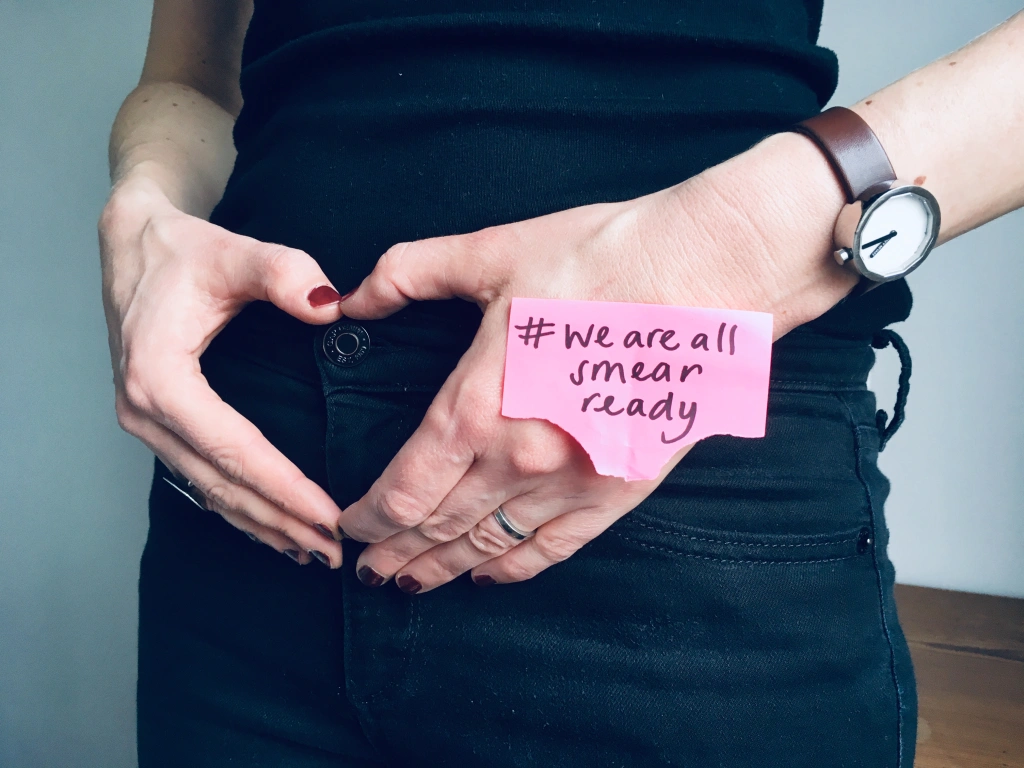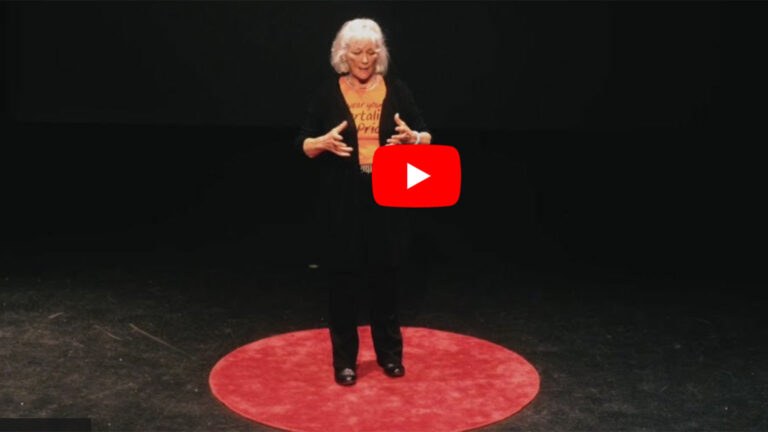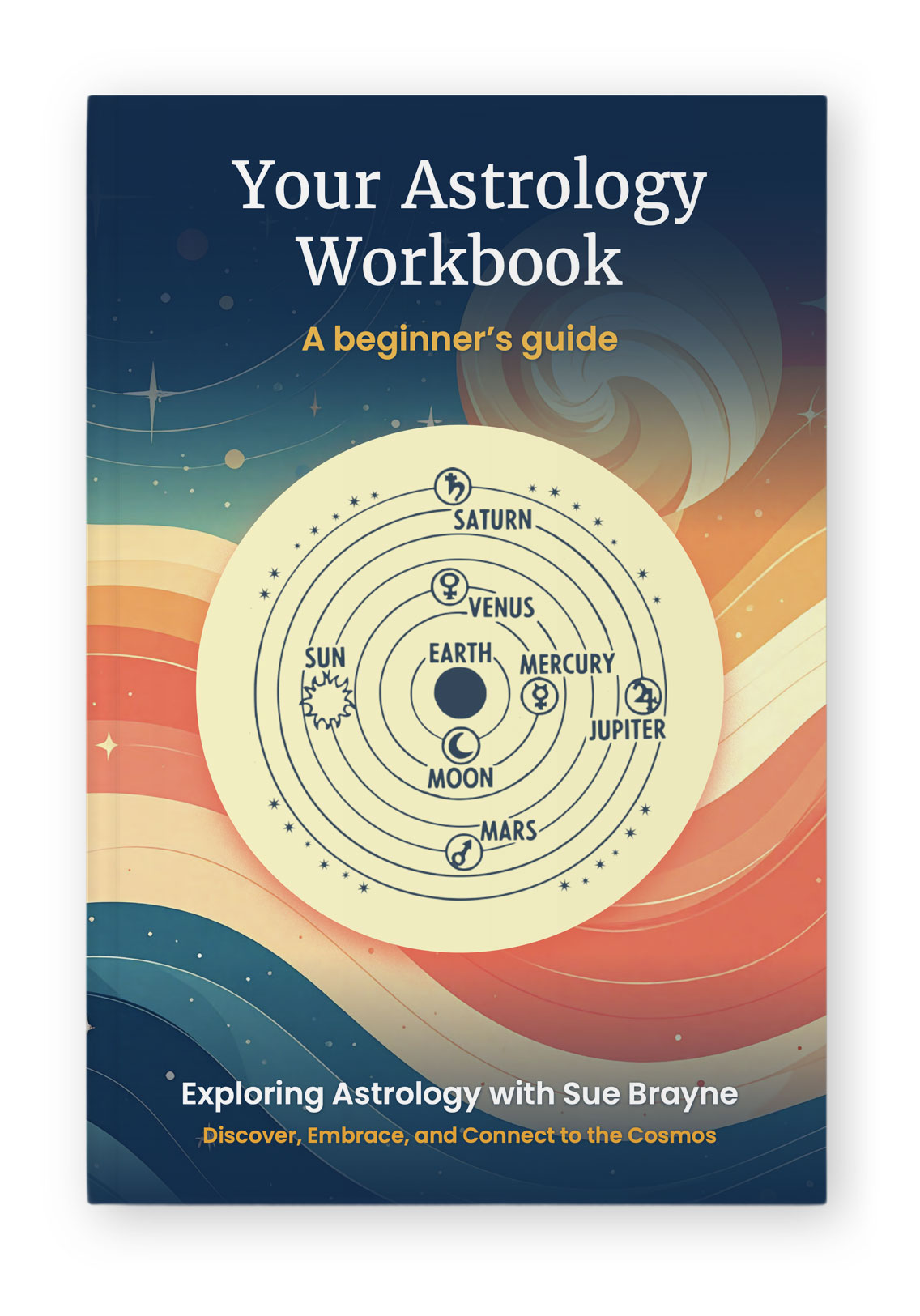
Helen Baker runs Helen Baker Design and she is passionate about using Craftivism as a way of promoting non-aggressive activism. Her mini pants campaign to encourage young women to have a smear test attracted nation-wide attention.
Sue: Welcome Helen! I hadn’t heard of Craftivism until you told me about it, so I am really interested to find out how it can help us all to live more consciously for a better world. But first, tell me how you got into it and the impact it’s had on your life.
Helen: Years ago, my mum gave me a book on craftivism by Sarah Corbett, who created the whole concept. I started reading the book on a train journey and I just devoured it. I was so inspired because I realised Craftivism is a way of getting a message across by using craft in a very gentle, yet effective way. That really resonated with me because I’m an introvert at heart, yet I wanted to make a protest about things that were going on. But I find things like big marches particularly draining and I also tend to feel that those kinds of protests are often remembered for the wrong reasons. For example, they’re often remembered for the tone and anger that’s evoked in people rather than for the actual message.
Sue: So, Craftivism is about some form of activism?
Helen: Yes. It focuses on the message and a gentle form of protest to get the word out there. At the time, I wanted to create a campaign for the awareness of smear tests. I had read in the media that smear attendance rates were at an all-time twenty year low. A dear friend of mine had also died of cervical cancer. I then received an invitation to attend my own smear test appointment. But flicking through the 16 page heavily laden text booklet which was enclosed with the letter made me realise it wasn’t really connecting with its female audience.
Sue: And, let’s face it, smear tests aren’t a particularly pleasant thing to experience!
Helen: I agree with that! But this became a proper light bulb moment for me because I didn’t feel this booklet was addressing the emotions or the concerns that women had. Then I realised that craftivism was the perfect tool to get my message across about the importance of smear tests in a very gentle way, and in a way that suited me. The very nature of this campaign is a delicate subject, and therefore needs to be sensitively addressed.
Sue: Do you have to be creative to be to get engaged in craftivism?
Helen: No, you don’t. This is not about making placards. It’s about trying to think of an unusual and eye-catching, thought provoking way to get your message across. This message could be about anything, but it’s something you feel that we as a society need to take more notice of.
Sue: So, it needs to be a protest or campaign that will benefit us all in some way?
Helen: Yes. But it’s moving away from an extrovert way of campaigning and becoming focused on empathy. So really stepping into other people’s shoes, and exploring what the problems are, and using craft, in what whatever way that may be, to bring attention to these issues. It’s not about being brilliant at craft either. In fact, those little mistakes are really endearing, because they show that whatever has been made has been lovingly handcrafted. But the emphasis is on using Craftivism to think differently about issues; to really focus and think about what message you are creating as you work on your project. What are the challenge and solution you are thinking about?
Sue: What’s coming into my mind is women sewing together or knitting together and that kind of thing. But this seems different because it addresses that need to come together and have a real focus on something important, rather than just having a cup of tea and a gossip.
Helen: Exactly! It’s craft with a purpose. When you’re doing something for a purpose, it has a lot more strength behind it. And also doing an activity with others, it helps you to think about the issues and how people might react. It also really helps when you’re working with tactile fabrics. It encourages people to talk together about how best to creatively address the issue because often, when you’re creating something as a group, you’re not necessarily making eye contact with another person. You’re focusing on what’s in front of you and what you’re doing.
When I’ve run workshops with other people, and we’ve created some craft, we’ve ended up talking about topics in real depth, and often people will say, ‘I haven’t shared this with anyone else before.’ But they feel okay to say it because they are in a very safe space with like-minded people. Creating this sort of shared goal of wanting to be proactive and do something positive in the world brings out a really nice, safe, social kind of environment for people to be really creative together.
Sue: I love this! Most people think activism is about being angry and getting arrested these days. But you’re saying, No. There’s a completely different but just as effective way of putting your point across.
Helen: Yeah. A lot of it is thinking about who you want to contact or how to grab their attention. And rather than having this us-versus-them mentality, it’s always about trying to set up a relationship of being a kind of critical friend. For example, your local MP might not share the same values as you, and you feel frustrated about some of the things they have done or implemented. So, it’s about trying to think how you want to work with them and how to find a way of opening up a relationship and saying, ‘Look, I’m one of your constituents. I’d really like some help with this. Can we sit down and have a discussion about it?’ It’s acknowledging positions of power that people have, but approaching them in a very open way is really effective to actually forming a relationship in which you can hopefully make some sort of social change.
Sue: Are you saying that, for instance, you want to connect with your MP and you’re going to invite him or her to a Craftivism session? I mean, would your MP really take up this offer?!
Helen: Well, possibly, you could do that. Sarah Corbett got to the point where she was writing and emailing her MP so much that her MP’s office actually asked her to stop because they couldn’t handle the volume of correspondence from her! This made her think there must be another way of making communication with them that wasn’t just about sending emails or forwarding on petitions. She realised it isn’t engaging enough because it doesn’t impact someone emotionally. So, what she did, and it’s a sort of template that she’s used for other people as well, is that she created what she calls her ‘Handkerchief.’ This is literally about encouraging people not blow their positions of power. Set up a dialogue instead.
Sarah gets a plain handkerchief and hand stitches her message onto it. Then wraps it up as gift, and asks for a meeting, explaining that she’s created something she wants to share with, for her example, her MP. It is all about building a positive working relationship between MP and constituent, rather than going into battle. The message is, ‘Let’s get our heads together and work towards a common goal model,’ because hopefully, MPs want to help and listen to their constituents. Sarah’s Handkerchief gift sets up a much stronger foundation to have this dialogue. And, since she used her Handkerchief gift, she’s now working with her MP on so many different issues, because she’s got a relationship with them.
Sue: What a wonderful idea to create a message on a handkerchief and send it to someone to grab their attention!
Helen: She does a lot of research first even down to the sort of colours that they wear and crafts a message that reflects who they are and explains why she wants something changed, often including a quote from someone inspirational to them. So, there’s always a robust kind of argument behind it. So, it’s sort of building a package that the person can’t really say no to, because it’s thought provoking. This isn’t just another email. This is a gift that has taken hours to craft, and hours of time and thought have gone into it.
Sue: Wow! I would be amazed to receive something like this. It’s so different. It’s ingenious!
Helen: Yes, it is. Sarah did a similar campaign using the handkerchief model with Marks and Spencer. She was contacted by a campaign organisation concerned with raising minimum wage of workers to living wage standards. They had got nowhere for the past three years, so they wanted to find a way of using Craftivism to grab the attention of M&S’s CEO. Sarah sat down and thought about the fact that the CEO had to report to a board of directors.
She then looked at all 13 board members and allocated each board member to craftivist friends to research their position and where they’d come from. All this information is readily available through the internet and LinkedIn – it’s using a very clever, emotionally intelligent way to find out what their passions and interests are.
Each person embroidered a personal message on an M&S handkerchief, saying, ‘We love your products, but we want you to pay attention to the minimum wage not just for your employees, but for the high street by setting this example.’
They then each bought a share in M&S so they could go to the shareholders AGM and presented their handkerchiefs to the board members! The board members were a little reluctant at first to take any sort of package, but they loved them. In fact, they all were really eager to come and find the crafters who had made the handkerchiefs. This opened up the conversation about the minimum wage issue. Around ten months later, the minimum wage was raised to living wage standards for over 50,000 M&S employees. The CEO actually said that this Handkerchief craftivism was one of the most powerful campaigns that M&S had ever seen. One of the handkerchiefs has actually gone into the M&S archives because it enabled change in the history of M&S. That’s so powerful to me. It gives me goosebumps.
Sue: What an incredible story! Craftivism sounds very women driven. Do men get involved as well?
Helen: It is largely women, but not solely. When I ran a pop-up craftivism event, I talked to both men and women about the smear campaign I was doing. The men were equally interested in the campaign. But it was mainly the women who actually did the craft with me.
Sue: I would love to hear more about your smear craftivism campaign. It’s seems like the perfect example of what someone can do to make change social happen.
Helen: As I mentioned, I was deeply affected by my friend’s death from cervical cancer and reading that smear tests save 70% of cervical cancer developing. During my research I discovered that the highest risk group for cervical cancer are between the ages of 25 and 29 yet one in three aren’t attending their appointments. Some of the biggest barriers were body image and embarrassment. I realised that this age group is the Instagram/snapchat generation who are very much focused on their external looks. So, this was about educating women about the important of their internal health as well.
I then did my own research, asking women I knew in the same age group about how they reacted to smear tests. A lot of them also said they were too embarrassed to go and that they put off appointments. They knew they should go but it was easier just to ignore it.
Sue: That’s really shocking.

Helen: Well, it took the death of a friend to realise how important smear tests are for me to understand this issue. I was also deeply affected when Jade Goody died of cervical cancer ten years ago aged 27, leaving two young sons. She died on Mother’s Day, and every Mother’s Day I remember her because of this.
I realised that this age group hang out on social media. So I decided I wanted to create an accessible, relatable, shareable content online – a sort of infographics, which explained the national context which we called We’re all smear ready (#weareallsmearready). I launched it on International Women’s Day 2019. It really resonated with women, but this was before I thought of how I could incorporate Craftivism to build on this message.

I initially had the idea of encouraging women to tear a post-it note into the shape of a pair of mini pants and write the hashtag #weareallsmearready.
I noticed that people were doing this in all different ways, which made me want to explore it further through using a craft that brings women together to create mini pants out of fabric. The joy of this is that you can use any scraps you have lying around at home. For example, I used my granny’s old tablecloths.
I got in touch with Sarah Corbett, who thought the mini pants smear campaign was a great idea. She encouraged me to make labels to go with the pants, which added the national context. A group of us then stuck the pants and labels on the back of toilet doors, on community noticeboards, on mannequins, in shops and on post boxes.
Sue: You got a group of people together to help you with this?
Helen: Oh, yes. Loads of people wanted to get involved and make their mini pants in their own way. I put a template on my website, but people just got creative with what they had at home! In fact, this year I encourage people to make rainbow pants as a thank you to the NHS nurses!
Sue: Do you know how much of an impact this has made?
Helen: I don’t because I don’t have access to national statistics, but the messages I’ve received personally from women is really uplifting.
Sue: It’s such a simple, yet fun and creative idea! It not shouting at anybody or saying you should do this otherwise you’re going to die, which a lot of official posters do. It’s about delivering a friendly, gentle, kind way of passing along a very important message.
Helen: Exactly. It’s using the Big Sister approach saying I know it’s not easy, but smear test can save lives. This is about prevention and education and reminding women that we are all in this together.
You can also have a lot of fun with it. The main campaign graphics has got daisies around the pubic area to represent your Lady Garden. You know, nurses really don’t care. They’ve seen it all before and it’s not what they’re looking at!
Sue: I understand that the BBC have picked up on your campaign.
Helen: Yes, it’s going to be part of a documentary on Craftivism, shown later in the year.
Sue: Where do you feel your relationship with Craftivism is heading?
Helen: I love the fact that more and more people are getting interested in Craftivism. And I’m learning a lot about it as a tool to get important messages across. So, I want to share this method with other people. I’m an ex-teacher and I find sharing ideas empowering. I plan to set up more workshops to bring people together to have those important conversations and to help them to think about how they can use Craftivism to promote their ideas. Therefore, it’s also about looking at your audience, considering any barriers this audience may have and thinking about how to market your idea effectively.
Sue: Do you think this works for everyone?
Helen: Yes. I witnessed this myself when I sat down and made smear test mini pants with my two young boys, who were aged 8 and 10 at the time. I took one of my sons to the doctor and he saw poster in the waiting room about smear testing. He turned to me and said, ‘Hey Mum, that’s what you do. You talk about smear tests.’
Sue: I can see Craftivism would be fabulous for sex education!
Helen: Yeah, exactly. This is where I would like the campaign to go next – into schools.
I can also see it paying an important role in areas of conflict. You know, all our voices matter. We want to belong and be heard. I think Craftivism allows people to do that. I had an extraordinary experience during last year’s National Cervical Screening Awareness Week. I was at a stall in town making smear mini pants and an older lady came up to me and asked what I was doing. Her initial reaction was one of disgust and she walked off. Half an hour later, she came back and said, ‘I’ve been thinking about what you’re doing. And I really want to get involved. I need to change how I feel about things.’ She sat down with me and I helped her to craft some mini pants. When she had finished to said, ‘I know exactly where I am going to put these up!’ She didn’t tell me where, but I was so moved that working together quietly and gently had changed her way of thinking. I found that so impactful.
Sue: That’s such a beautiful fit for what it means to be living more consciously for a better world.
Helen: Yes. It’s about getting curious so you can find ways to explore things in a different, non-aggressive way. Then get your friends, children and family involved and have fun! Anyone can get involved, they really can.








